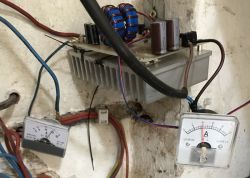It is GAZ4 instead of combining like a horse uphill and packing an additional panel (which works inefficiently for this), you need to use the MPPT regulator for the heaters and it will squeeze out of the panel or panels as much as possible. (especially when the weather is worse)
Example: The heater has the same parameters as the panel panel = ok super 100% power flies.
Sweet 50%
Power on the heater: 25%
Because the load resistance is the same and the source has 2 times greater internal resistance.
power curve not 45 degrees only 78 degrees ... so wears even higher
Such an example in the photo

And here is a very mismatched panel power / heater power and voltage:
4XGS50 panels (43V Vmpp actually have less) = 200W
Heater 12V 300W
As you can see, the system adjusts the heater resistance to the resistance of the panels at their optimal operating point and the system works with maximum possible efficiency from morning to evening.
And there is no risk of damaging the heater (even if the power of the panels = 300W).
Half measures are not a solution, okay, "a little" works, but I would not be satisfied with this.
That is why this regulator was created and if you do not need hot water, it charges the 12V batteries. A 2-in-1 that makes sense.



